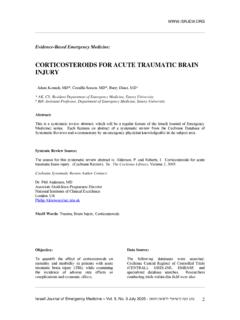Transcription of Lipoprotein(a) : Lp(a)
1 Lipoprotein(a) : Lp(a). Proven to be the best methodology on the market Background Cardiovascular disease (CVD) and more specifically, Myocardial Infarction (MI) remains a leading cause of morbidity and mortality, despite the targeting of LDL cholesterol via statin therapy. There is a need for additional causal risk factors, beyond the traditional LDL measurement1. Large scale studies and international guidelines published between 2009 and 2010, have proven that Lp(a) is a major independent genetic risk factor for premature CVD and should be screened in all patients at moderate to high risk.
2 What is Lipoprotein(a) : Lp(a)? Lp(a) is a major independent genetic risk factor for cardiovascular disease2. Lp(a) particles are similar to LDL consisting of a cholesterol-rich core, with an apoB-100 protein attached3. However, Lp(a) uniquely differs to LDL in that it also has an apo(a) protein attached via a disulfide bond (see diagram). The apo(a) is comprised of a series of kringle structures There are 10 types of kringle IV and only one copy of each type except for type 2. Kringle IV, type 2 (KIV2) is particularly susceptible to being manufactured repeatedly, depending on an individual's genetics (2-40 repeats).
3 The number of KIV2 repeats generates different isoforms and a major affect on the size of the apo(a) protein which affects the level of Lp(a). Apo(a) is synthesised in the liver and binds to newly synthesised apoB-100. The size of the apo(a) protein is genetically determined and varies widely1 hence, levels of Lp(a) can vary up to 1000-fold between individuals1. Plasma levels rise shortly after birth up to a consistent level within several months, typical plasma levels of Lp(a) are similar in men and women: one in five (20%) have levels above 50 mg/dL. 2010 Guidelines on Lp(a) 4.
4 Recent years have seen major scientific advances in the understanding of Lp(a) and its causal role in premature CVD. Elevated Lp(a) levels associate robustly and specifically with increased CVD risk. This association is continuous and does not depend on high levels of LDL or non-HDL cholesterol, or the presence of other CVD risk factors. Lp(a) levels, like elevated LDL, is causally related to premature development of atherosclerosis and CVD. Table I Comparison of evidence supporting the contention that elevated LDL cholesterol and elevated Lp(a) each cause cardiovascular disease4.
5 Assay details Elevated LDL cholesterol Elevated Lp(a). Human epidemiology Direct association in numerous studies Direct association in numerous studies Human genetic studies Direct association in numerous studies, Direct association in numerous studies, familial hypercholesterolaemia for kringle IV type 2 polymorphism Mechanistic studies Mechanism clearly demonstrated: LDL Mechanism similar to that for LDL cholesterol accumulates in intima and causes atherosclerosis and/or prothrombotic/anti-fibrinolync effects Animal models Proatherogenic effect in numerous studies Proatherogenic effect in numerous studies Human intervention trials Statin trials gave final proof of causality Niacin trials are favourable Whom to screen?
6 4. The European Atherosclerotic Society suggest that Lp(a) should be measured once in all subjects at intermediate or high risk of CVD/CHD who present with: i. Premature CVD. ii. Family hypercholesterolaemia iii. A family history of premature CVD and/or elevated Lp(a). iv. Recurrent CVD despite statin treatment v. 3% 10-year risk of fatal CVD according to the European guidelines vi. 10% 10-year risk of fatal and/or non-fatal CHD according to the US guidelines Repeat measurement is only necessary if treatment for high Lp(a) levels is initiated in order to evaluate therapeutic response.
7 The evidence clearly supports Lp(a) as a priority for reducing cardiovascular risk, beyond that associated with LDL cholesterol. Clinicians should consider screening statin-treated patients with recurrent heart disease, in addition to those considered at moderate to high risk of heart disease - EAS Consensus Panel 5. Desirable Levels 4. Table 2 Desirable levels for low-density Lipoprotein cholesterol and lipoprotein(a) levels in the fasting or non-fasting state4. Patients with CVD Other patients and Highest level of evidence and/or diabetes individuals for treatment LDL cholesterol < 2 mmol/La (<77 mg/dL) < 3 mmol/La (116 mg/dL) la: meta-analysis of randomised, controlled trials of statin treatment Lp(a) < 80th percentile (<~50 mg/dLb) < 80th percentile (<~50 mg/dLb) la: meta-analysis of randomised, controlled trials of niacin treatment a According to the 2007 European guidelines The 80th percentile roughly corresponds to 50 mg/dL in Caucasians.
8 B How to treat elevated Lp(a)? Patients with moderate or high risk of CVD should be screened If Lp(a) is above cut-off the primary focus of treatment should for Lp(a) 1 be on reducing the patient's In addition, niacin therapy can be considered, particularly in high risk patients, as this has been Reducing Lp(a) to below cut-off should be a treatment priority, shown to reduce Lp(a) by 30-40%.1 Niacin-based therapies along with the lowering of LDL cholesterol1 have been shown to improve patients' atherogenic lipid profile (increases HDL-C, decreases LDL-C, decreases Lp(a). Lp(a) levels are generally not strongly affected by lifestyle and decreases triglycerides).
9 Changes1. LDL apheresis which removes Lp(a) efficaciously8 should be In general, serial measurement of Lp(a) is not required and only considered in young or middle-aged patients with evidence of needs to be repeated if evaluating therapeutic response progressive coronary disease and markedly elevated plasma Lp(a) 4. Choosing your Lp(a) assay Lp(a) levels are heavily influenced by the size of the attached apo(a) protein7. The size variation of apo(a) represents a serious challenge in the immunochemical measurement of Lp(a) for the following reasons7: i. The antibodies should have isoform-insensitive immunoreactivity to apo(a).
10 Ii. The choice of apo(a) size in the assay calibrator tends to be random and is not representative of all possible apo(a) size variations found in the general population iii. Depending on the size of apo(a) used in the calibrator, many commercially available assays either underestimate or overestimate the concentrations of Lp(a) in plasma hence they are strongly affected by apo(a) size-related bias . Utilisation of an inadequate methodology for Lp(a) is highly likely to lead to increased numbers of both false negatives and false positives7 . This will lead to the potential misclassification of a significant number of both high and low risk Randox Lp(a) Assay Details Proven to be the best methodology on the market T.





